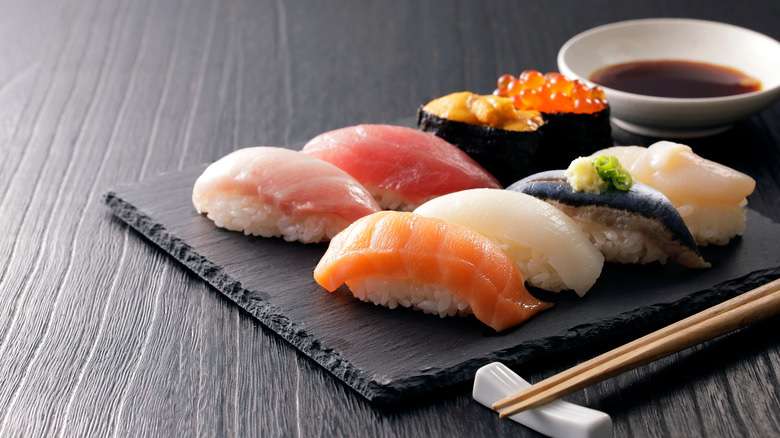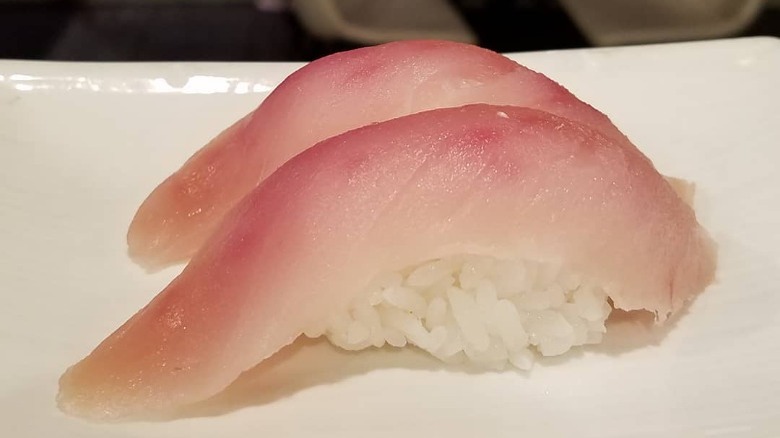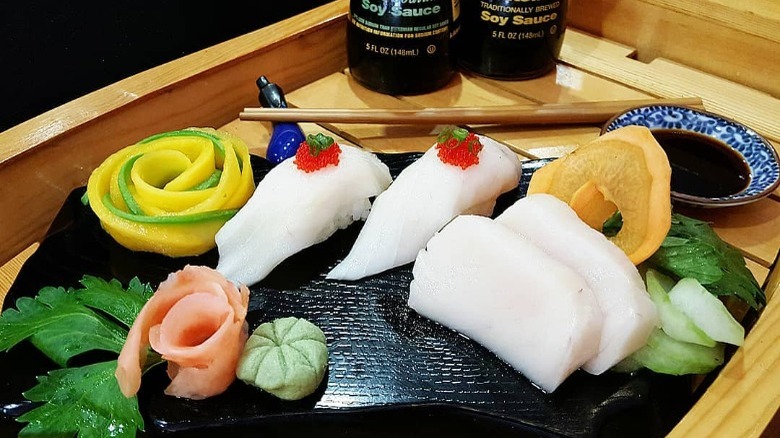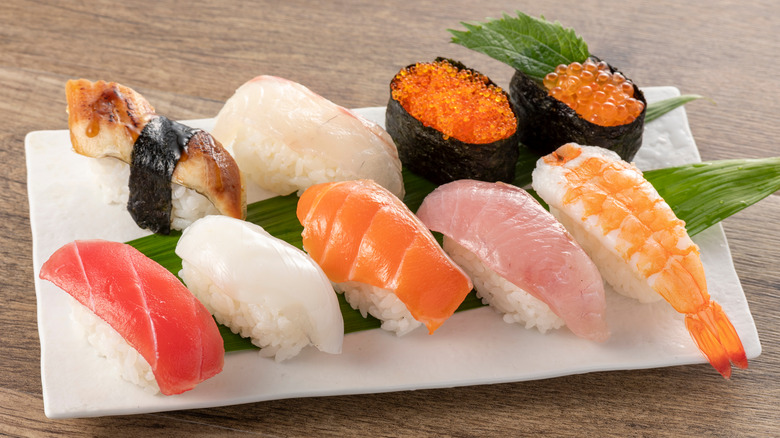What You May Actually Be Getting When You Order 'White Tuna' Sushi
There are nine basic types of fish you'll commonly see on sushi menus, according to The Spruce Eats: salmon, tuna, squid, yellowtail, mackerel, hirame (with can be either halibut or flounder), mollusks, bass, and shad. Within each category, there are variations that can make your experience significantly different, even if you believe you're ordering the same menu item. (For example, bass — often labeled suzuki or tai — could be seabass, porgies, or snapper.) And while it would be understandable to assume your sushi is made with Japanese salmon, NPR explains that is unlikely, as it took Norwegian fish to get salmon rolls on the menu.
While getting Norwegian fish in your Japanese sushi may feel a bit misleading, you're at least getting the salmon as advertised, even if it's from a different part of the world than you might expect. However, the same can't easily be said of white tuna, which is often subjected to seafood fraud, according to a report published by the Center for Agriculture & Food Systems. Seafood fraud happens for a few reasons, including when catches are misclassified as other, typically more desirable, types of fish to appear more marketable, as is often the case with white tuna, meaning when you order it at your favorite sushi bar you might not be getting tuna at all.
There's only one white tuna
Before you get alarmed, white tuna is a real fish. Also called shiro maguro, per The Japanese Bar, true white tuna is made with albacore, a small species of tuna distinguished by its dark blue and light blue coloration (via World Wildlife Fund). Commonly found in the Pacific Ocean, NOAA Fisheries reports it is further divided into North Pacific and South Pacific stocks. Albacore tuna is formally classified as part of the thunnus genus together with other tuna species (via Integrated Taxonomic Information System).
California fish market Catalina Offshore Products explains that, in the U.S., albacore tuna is the only fish that can be sold legally under the white tuna or shiro maguro name, but the term is often — intentionally or not — used to describe other types of white fish in Japanese restaurants. So how does fake white tuna slip through the cracks and make it onto your sushi plate?
Albacore's lookalike, escolar
Escolar is a tuna bycatch, according to Seafood Source. After being hauled in along with the more desirable tuna, the fish is sometimes sold in markets and restaurants under the name white tuna (via Los Angles County Department of Public Health). Though you may also see escolar marketed as "super white tuna" or "king tuna," per Kitchn, escolar is not, in fact, a type of tuna at all but a variety of snake mackerel — and it also goes by the more concerning name "ex-lax fish."
The problem with the mislabelling of escolar goes beyond just protecting legal classifications and ensuring consumers are getting what they pay for. Escolar poses a considerable health concern if eaten in large quantities, as the Queensland Government reports nearly 90% of the fish's oil is made of "indigestible wax esters." These oils can cause upset stomachs and other unpleasant gastrointestinal issues, so it's recommended escolar only be eaten in smaller amounts — less than 200 grams (or about six ounces) at a time.
Identifying and avoiding escolar in sushi
While escolar may look close enough to albacore to pass as shiro maguro at first glance, there are key distinctions between the two fish you can look for when your plate arrives at the table. Tuna is known for its red hue, which The Washington Post explains is a result of the myoglobin in the cut fish being exposed to air. While albacore will be a much paler pink than red tuna, hence the name "white tuna," it is not a pure white color like you might assume. In comparison, escolar is snow-white, according to Catalina Offshore Products.
And if you're wanting to avoid escolar altogether, not just identify it in your sushi order, chef Yoshikiko Kousaka suggests you simply not order "white tuna" at all. The chef told Food Republic white tuna is so often in fact escolar he personally avoids anything bearing the label. If the experience of eating real shiro maguro is important to you, you may want to ask your server whether you're getting albacore before placing your order or only opt for white tuna if the menu explicitly names the fish.



